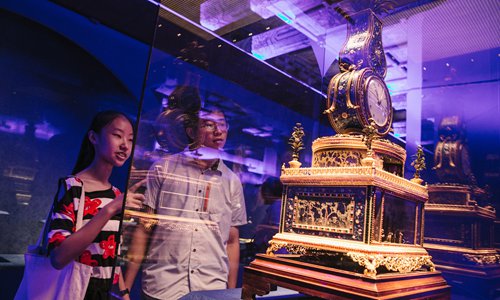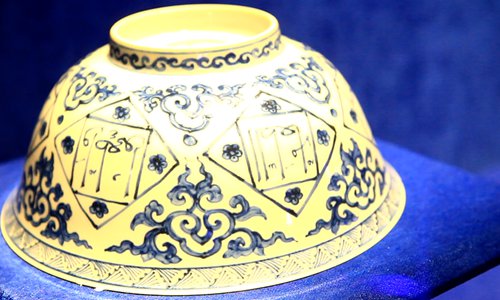
Visitors appreciate a Qing Dynasty (1644-1911) clock (Photo: Li Hao/GT)

A porcelain bowl decorated with Arabic writing (Photo: Li Hao/GT)
Porcelain decorated with European-style patterns or writing in Arabic or English, a painting of the Qing Dynasty (1644-1911) Yongzheng Emperor sporting the same wig English lords wear - the exhibits on display at the Palace Museum and the Maritime Silk Road Exhibition cannot be simply classified as being solely Eastern or Western art.
They are some of the best examples of the important role maritime trade had played in the cultural communication between China and the West.
The exhibition at the Palace Museum in downtown Beijing explores this cultural fusion in three sections - the first is made up of items that China sent to other countries, for example porcelain, which had a huge impact on ceramics in many parts of the world; the second section features gifts and cultural and scientific products that spread to China from other countries; while the third section delves into how Eastern and Western culture impacted each other.
"We hope to use the Palace Museum's collection to show people how the imperial families of the Ming (1368-1644) and Qing dynasties interacted with the outside world," Zheng Hong, curator of the exhibition and also a porcelain expert at the Palace Museum, told the Global Times on Tuesday.
The perfect icebreaker
"Western clocks opened a window for missionaries to enter into the imperial palace," Zheng said.
Although products from China such as porcelain spread quickly in the West due to their popularity, it wasn't as easy for Western culture to be presented and fully accepted by the Chinese upper class.
Clocks reversed this situation, causing the emperor and other members of the upper class to take notice of the Western missionaries who were bringing these advanced mechanisms into China.
Clocks became the go-to gift for foreigners after the Ming Dynasty Wanli Emperor highly praised the timepieces that were presented to him by Matteo Ricci, an Italian Jesuit missionary.
"It was believed that clocks demonstrated the advanced technology of Europe. The emperors of China found them greatly inspiring, so they became the first choice of gifts among foreign missionaries," Zheng said.
On display at the exhibition are several luxurious and gigantic tower-like clocks. Exquisitely carved with tiny miniature figures, these gold gilded works of art shine under the display lights.
Zheng said experts from other countries and regions told her that the clocks on display are actually much more lavish than those intended to be sold in their home countries.
Science and medicine
"The Kangxi Emperor [1654-1722] was very open-minded about Western science and medicine. His interest greatly helped the spread of Western medicine in the royal palace," Zheng Hong said.
Kangxi, the longest-reigning emperor ever at 61 years on the throne and considered one of the most learned ones, was highly influential when it came to establishing the prosperity of the Qing Dynasty.
Kangxi's enthusiasm in learning about science is very obviously on display at the exhibition. Many of the textbooks and tools he used to learn math can be seen. Some astute visitors may notice that the little table he used while studying also has different rulers carved into it.
According to Zheng, Kangxi was also very passionate about astronomy. When the emperor order a map of China be created in the year 1708, he personally took part in some of the fieldwork carried out by Western and Chinese experts, putting his knowledge of the stars to use to help determine latitude. The introduction of Western astronomy was a great help in improving the Chinese calendar.
His passion for astronomy is also reflected in the many paintings at the exhibition of concubines' rooms decorated with armillary spheres.
Kangxi was also a key figure for introducing Western medicine to China at a time when most people didn't trust it.
"Anatomy and some theories of Western medicine run contradictory to our traditional Chinese medicine, so many didn't believe in it," Zheng said. However, Western medicine helped treat Kangxi after he came down with a case of malaria. This caused him to trust Western medicine, which he then promoted throughout the palace.
"During the reign of the Yongzheng Emperor [1722-35], Western medicine was fully accepted in the palace. However, after that Western medicine wasn't accepted for a time and wouldn't return to the palace until the 19th century," Zheng said.
New perspectives
Western culture also influenced the art world in China through the introduction of oil painting techniques and Western approaches to perspective.
Zheng explained that many of the paintings on display at the exhibition were created by both Chinese and foreign artists. He pointed out a number of paintings whose landscapes were painted in a typical Chinese style, but that featured animals such as dogs and horses that were painted in a way in which they seemed to come from a Renaissance oil painting. Even some of the dog breeds were those that originated in the West.
The technique behind the making of aventurine glass, a glittering glass made in an oxygen-reduced atmosphere, was another skill that Western missionaries brought to China. During the Qianlong period (1736-96), Chinese experts fully mastered this technique to produce their own attractive aventurine glass products.
Heading out
Cultural exchange was not just a one way street. As Western culture and goods flowed into China, Chinese culture and goods also headed out into the world.
As porcelain was introduced in great amounts to Western countries through seafaring merchants during the 15th-16th centuries, demand for it continued to increase. Demand was especially high for porcelain from famous kilns such as Jingdezhen in East China's Jiangxi Province. As purchases from foreign merchants increased, local kiln makers began catering to their customers by creating porcelain with Western elements such as famous Western figures or decorating pieces with English writing.
Arabic writing can also be seen on porcelain from the period. Zheng explained that Islamic elements and Arabic writing can be found on many pieces of porcelain in the museum's collection. This mainly stems from the Ming Dynasty Zhengde Emperor's (reign: 1505-21) interest in Islamic culture.
The exhibition, which ends on July 8, has more than 140 relics from the museum's Ming and Qing dynasty collection.


















































